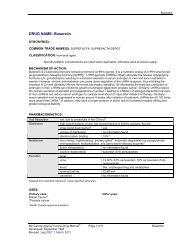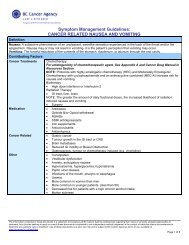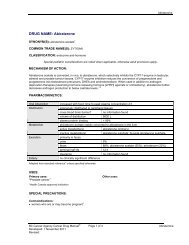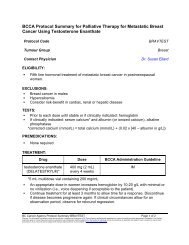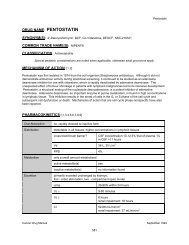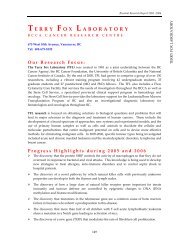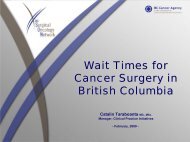CCSP manual - BC Cancer Agency
CCSP manual - BC Cancer Agency
CCSP manual - BC Cancer Agency
Create successful ePaper yourself
Turn your PDF publications into a flip-book with our unique Google optimized e-Paper software.
SCREENING FOR<br />
CANCER OF THE CERVIX<br />
An Office Manual for Health Professionals<br />
This <strong>manual</strong> has been prepared by the Cervical <strong>Cancer</strong> Screening Program<br />
of the <strong>BC</strong> <strong>Cancer</strong> <strong>Agency</strong> to support effective use of the screening program.
Contact Information<br />
Cervical <strong>Cancer</strong> Screening<br />
Program (<strong>CCSP</strong>)<br />
Medical Leader<br />
Phone: 604-877-6000 Local 2068<br />
Fax: 604-629-2507<br />
E-mail: jmatisic@bccancer.bc.ca<br />
Chief Technologist<br />
Phone: 604-877-6000 Local 4906<br />
Fax: 604-629-2507<br />
E-mail: mkumpa@bccancer.bc.ca<br />
Operations Leader<br />
Phone: 604-877-6201<br />
Fax: 604-660-3645<br />
E-mail: sking@bccancer.bc.ca<br />
Program Secretaries<br />
Phone: 604-877-6000 Local 6200 or 4904<br />
Fax: 604-660-3645<br />
E-mail: mpreston@bccancer.bc.ca<br />
jsentell@bccancer.bc.ca<br />
Provincial Colposcopy Program<br />
Medical Leader<br />
Phone: 604-877-6000 Local 2355<br />
Fax: 604-877-6179<br />
E-mail: lbenedet@bccancer.bc.ca<br />
Tumor Group Chair<br />
Phone: 604-877-6000 Local 2354<br />
Fax: 604-877-6179<br />
E-mail: dmiller@bccancer.bc.ca<br />
Pap Smear Supplies<br />
Lower Mainland<br />
Phone: 604-877-6000 Local 2116 or 2111<br />
Fax: 604-629-2510<br />
Outside of Lower Mainland<br />
Phone: 1-888-248-9508<br />
Fax: 604-629-2510<br />
Website<br />
www.bccancer.bc.ca<br />
Acknowledgments<br />
The Cervical <strong>Cancer</strong> Screening Program<br />
of the <strong>BC</strong> <strong>Cancer</strong> <strong>Agency</strong> would like to thank<br />
Dr. A. J. Kotaska, General Practitioner,<br />
Dr. R. M. Malleson, Director, Family Planning<br />
and Dr. D. Miller, Chair, Gyne Tumor Group,<br />
<strong>BC</strong> <strong>Cancer</strong> <strong>Agency</strong>, Vancouver <strong>Cancer</strong> Centre,<br />
for their valuable advice and contribution.<br />
Staff & Contributors<br />
Dr. R. Amy, Pathologist<br />
Dr. L. Benedet, Director,<br />
Provincial Colposcopy Program<br />
Dr. A. Coldman, Leader,<br />
Population & Preventive Oncology<br />
Dr. M. Hayes, Pathologist<br />
L. Kan, Screening Information Management Leader<br />
S. King, Screening Operations Leader<br />
M. Kumpa, Chief Cytotechnologist<br />
J. Lo, Section Head, Cytotechnologist<br />
Dr. J. Matisic, Pathologist/Medical Leader, <strong>CCSP</strong><br />
Dr. R. O’Connor, Pathologist<br />
M. Preston, Secretary<br />
J. Sentell, Secretary<br />
Dr. K. Suen, Pathologist<br />
Dr. T. Thomson, Pathologist<br />
Dr. D. van Niekerk, Pathologist<br />
Cervical <strong>Cancer</strong> Screening Program<br />
Administration Office<br />
8 th Floor<br />
686 West Broadway<br />
Vancouver, <strong>BC</strong> V5Z 1G1<br />
Phone: 604-877-6000 Local 4904<br />
Fax: 604-660-3645<br />
Fifth Edition 2002
Table of Contents<br />
Introduction<br />
Components of the Cervical <strong>Cancer</strong> Screening Program ................................................................................1<br />
- Recruitment, Recall and Follow-up<br />
- Centralized Laboratory Services<br />
- Quality Assurance and Quality Control<br />
- Evaluation<br />
- Colposcopy Service<br />
Limitations of Screening – Screening Tests are not Diagnostic Tests .........................................................2<br />
Facts About Screening and Cervical <strong>Cancer</strong>.........................................................................................2<br />
<strong>BC</strong> <strong>Cancer</strong> <strong>Agency</strong> Screening Recommendations<br />
General ..........................................................................................................................................................3<br />
Post-Hysterectomy Screening Guidelines........................................................................................................3<br />
Lesbians .........................................................................................................................................................4<br />
Role of the Smear Taker...........................................................................................................................4<br />
The Patient..................................................................................................................................................5<br />
Pap Smear Technique<br />
Labeling the Slide...........................................................................................................................................6<br />
Single Slide Method .......................................................................................................................................6<br />
Variations in Cervical Transformation Zone ...................................................................................................6<br />
Basic Equipment and Supplies........................................................................................................................7<br />
Obtaining the Smear ......................................................................................................................................7<br />
Completing the Requisition Form...........................................................................................................8<br />
Transporting the Specimen .....................................................................................................................8<br />
Specimen Rejection Policy.......................................................................................................................8<br />
Optimal and Unsatisfactory Smears ......................................................................................................9<br />
Human Papilloma Virus and Cervical <strong>Cancer</strong>.....................................................................................10<br />
New Technologies....................................................................................................................................10<br />
Liquid Based Cytology (Thin-Layer Cytology).............................................................................................10<br />
Machine-Assisted Screening .........................................................................................................................10<br />
Appendix I: Guidelines for the Investigation and Management of Women with Screen Detected Abnormalities... 11<br />
Appendix II: Management of Women with Low Grade Epithelial Abnormalities (Mild Dysplasia or CIN 1) .. 12<br />
Special Categories ................................................................................................................12<br />
Appendix III: Understanding False Negative Rates.....................................................................................13<br />
Appendix IV: Results Terminology.............................................................................................................14<br />
References................................................................................................................................................15<br />
Educational Materials Order Form.......................................................................................................16<br />
Feedback Form ........................................................................................................................................17
Introduction<br />
The Cervical <strong>Cancer</strong> Screening Program (<strong>CCSP</strong>), operated by the <strong>BC</strong> <strong>Cancer</strong> <strong>Agency</strong> (<strong>BC</strong>CA) is a<br />
coordinated program of cervical cancer control. The <strong>CCSP</strong> is available to all women in the province.<br />
Components of the Cervical <strong>Cancer</strong> Screening Program<br />
Recruitment, Recall and Follow-up<br />
In a true “population-based” screening program,<br />
all at-risk women are personally invited to<br />
participate. At this time, recruitment to the <strong>CCSP</strong><br />
is “opportunistic,” i.e.; family doctors and other<br />
health professionals initiate the collection of a Pap<br />
smear from their patients. The Program’s centralized<br />
computer system provides a coordinated system of<br />
recall and follow-up by sending reminders to the<br />
woman’s care provider.<br />
Centralized Laboratory Services<br />
All Pap smears collected around the province are<br />
forwarded to a central cytology laboratory operated<br />
by the <strong>BC</strong> <strong>Cancer</strong> <strong>Agency</strong>. Approximately 700,000<br />
smears are interpreted annually. As part of the<br />
central service, the laboratory distributes Pap smear<br />
supplies to physicians at no cost to them.<br />
Quality Assurance and Quality Control<br />
Quality assurance and quality control systems<br />
are based on recommendations provided by the<br />
Canadian Society of Cytopathology. The ability to<br />
decrease cervical cancer mortality through screening<br />
depends on four factors:<br />
• Women’s participation<br />
• The quality of the Pap smear<br />
• The performance of the laboratory<br />
• Adequate management/treatment of a detected<br />
abnormality<br />
To optimize these factors the Program provides:<br />
• Recruitment initiatives to encourage participation<br />
• Educational material to doctors and other care<br />
providers to enhance smear quality<br />
• A system of regular work reviews and continuing<br />
education for the cytotechnologist to enhance<br />
smear interpretation quality<br />
• The linked Provincial Colposcopy Program<br />
Evaluation<br />
Data is collected and analyzed on an ongoing basis<br />
to understand the Program’s effectiveness and to<br />
identify areas for improvement.<br />
Colposcopy Service<br />
The linked provincial colposcopy service<br />
investigates women with abnormal Pap smears.<br />
(If recommended, women should be referred<br />
promptly for colposcopy and a copy of the cytology<br />
result must accompany the referral letter).<br />
1
Limitations of Screening<br />
Screening Tests are not Diagnostic Tests<br />
Screening programs aim to reduce morbidity and<br />
mortality from cancer. Their goal per se is the<br />
“application of a relatively simple, inexpensive test<br />
to a large number of persons in order to classify<br />
them as likely, or unlikely, to have the cancer.” 1 The<br />
emphasis on likelihood underscores the limitations<br />
of screening (screening tests are not diagnostic<br />
tests). A person with an abnormal screening test<br />
does not have a definitive diagnosis until additional,<br />
more sophisticated diagnostic tests are completed.<br />
Screening test accuracy varies according to cancer<br />
site and individuals’ characteristics.<br />
Although most screening interpretations are<br />
accurate, it is inevitable that some individuals are<br />
identified as possibly having cancer when they do<br />
not (false positive screens) 2 , whereas others with<br />
disease are not identified (false negative screens).<br />
Facts About Screening and Cervical <strong>Cancer</strong><br />
The Papanicolaou (Pap) smear is a screening test<br />
for cervical squamous dysplasia and early invasive<br />
squamous carcinoma of the cervix. Glandular atypia<br />
can be detected in advanced pre-malignant lesions<br />
or in early adenocarcinomas. Some interesting facts<br />
about cervical cancer include:<br />
• In many countries where effective cervical<br />
screening is not available, the incidence rate of<br />
cervical cancer is high and increasing.<br />
• Most women diagnosed with cervical cancer in<br />
<strong>BC</strong> in the year 1999 had not had a Pap test in the<br />
past 3 years.<br />
• Despite the benefits of Pap testing, not all women<br />
take advantage of it.<br />
• The Pap smear is used to sample the<br />
asymptomatic woman who has a clinically normal<br />
appearing cervix. Those who are symptomatic<br />
require further investigation such as a biopsy,<br />
regardless of the result of the Pap smear test.<br />
Smears taken in the presence of symptoms are<br />
often unsatisfactory or have a higher false negative<br />
rate.<br />
• Cervical cancer behaves like a sexually transmitted<br />
disease. Human Papilloma Viruses (HPV), such<br />
as types 16, 18 and 45 are present in over 95% of<br />
cervical cancers. However, the majority of women<br />
who become infected with HPV, including those<br />
infected with high-risk subtypes, do not go on to<br />
develop invasive cervical cancer.<br />
• Other risk factors include:<br />
- commencement of sexual activity at a young age<br />
- multiple sexual partners or a partner who has<br />
had multiple sexual partners<br />
- history of other sexually transmitted diseases<br />
- immunosuppression or deficiency<br />
- smoking<br />
• Women who have never been sexually active<br />
have a low probability of developing cervical<br />
cancer. The health care professional should<br />
develop a rapport with these patients in order to<br />
feel confident that they have, in fact, never been<br />
sexually active. If there is any doubt, a Pap smear<br />
program should be initiated.<br />
• Evidence shows that women who have been<br />
screened regularly up to age 69 with negative<br />
smears will have a very low risk of developing<br />
cervical cancer.<br />
2<br />
1<br />
Cole P, Morrison AS: Basic issues in cancer screening. In Miller AB (Ed): Screening in <strong>Cancer</strong>. Geneva, International Union Against<br />
<strong>Cancer</strong>, 1978, page 7.<br />
2<br />
Miller, AB: Fundamentals of screening: In Screening for <strong>Cancer</strong>, Orlando, Academic Press, 1985, page 3.
<strong>BC</strong> <strong>Cancer</strong> <strong>Agency</strong><br />
Screening Recommendations<br />
Criteria<br />
Recommended Action<br />
Onset of sexual activity or soon after<br />
Start regular Pap smear screening<br />
Negative or benign changes<br />
Repeat smear every 12 months until there are<br />
3 consecutive normal smears then continue at<br />
24-month intervals<br />
Mild dyskaryosis (squamous and/or glandular)<br />
Moderate or higher dyskaryosis<br />
Repeat in 6 months<br />
Colposcopy examination is recommended,<br />
if mild atypia persists for 2 years<br />
Colposcopic examination is recommended<br />
After age 69<br />
Pregnant Women<br />
Stop screening, if there are 3 or more normal<br />
smears in the last 10 years and no history of<br />
previous significant abnormality (moderate atypia<br />
or higher)<br />
If no history of previous Pap smear, do Pap smear,<br />
otherwise follow guidelines as indicated in nonpregnant<br />
women<br />
HIV Positive Women<br />
Repeat smear in 6 months until there are<br />
2 consecutive normal smears then continue at<br />
12-month intervals<br />
Post-Hysterectomy Screening Guidelines<br />
Screening of the vaginal vault is not necessary if the<br />
woman meets all of the following conditions:<br />
• She has had a total hysterectomy (cervix removed)<br />
as opposed to a subtotal hysterectomy (cervix<br />
remains)<br />
• The hysterectomy was performed for a benign<br />
condition and no significant dysplasia was found<br />
• All previous Pap smears showed no significant<br />
abnormality (moderate atypia or higher)<br />
• If no previous Pap smear record is available and<br />
hysterectomy pathology is benign, the patient<br />
should have two consecutive, negative smears one<br />
year apart before discontinuing screening.<br />
3
Screening Recommendations continued<br />
Lesbians<br />
Research suggests that cervical cancer is found at a<br />
later stage among lesbians due to the widespread<br />
belief that lesbians don’t need Pap smears. This<br />
belief is untrue because:<br />
• Lesbians or their partners may have had<br />
consensual or non-consensual intercourse with<br />
men at some time<br />
• HPV in lesbians may be as prevalent as it is in<br />
heterosexual women<br />
Role of the Smear Taker<br />
All Pap smears submitted to the Cervical <strong>Cancer</strong><br />
Screening Program (<strong>CCSP</strong>) must be accompanied<br />
by the name of a licensed health care provider in<br />
British Columbia to whom the Pap smear result and<br />
follow-up letters can be sent. A “licensed health care<br />
provider” is a member in good standing of the <strong>BC</strong><br />
College of Physicians and Surgeons, the Association<br />
of Naturopathic Physicians of <strong>BC</strong> or a registered<br />
midwife designated by a woman as her primary<br />
health care provider. Certain nursing health stations<br />
in rural areas will also be acceptable if designated as<br />
primary health care providers.<br />
Smear takers play a key role in the <strong>CCSP</strong><br />
and are responsible for:<br />
• Identifying women for whom screening is<br />
recommended and maintaining appropriate call<br />
and recall systems.<br />
• Educating women about the benefits of screening<br />
while ensuring the limitations of screening are<br />
understood.<br />
• Educating women about the importance of<br />
regular smears.<br />
• Informing women of the need to seek medical<br />
attention for abnormal vaginal bleeding regardless<br />
of a normal smear result.<br />
• Ensuring women are referred for specialist<br />
assessment and investigation when required and<br />
coordinating their ongoing care.<br />
• Forwarding copies of smear results to a woman’s<br />
primary care giver (with her consent).<br />
The responsibility to follow up with<br />
individual women rests with primary care<br />
providers and should include:<br />
• Mechanisms to ensure a result is received for each<br />
smear taken.<br />
• Mechanism to inform the woman of the results,<br />
including normal results.<br />
• Protocols to ensure women are recalled as<br />
appropriate, for regular smears.<br />
• Protocols to ensure women with abnormal smears<br />
receive appropriate follow-up.<br />
4
The Patient<br />
The goal of an effective screening program is to<br />
screen all women at risk.<br />
• The single most powerful motivator for a woman<br />
to be screened is an invitation/suggestion by her<br />
health care provider. This is especially true for<br />
women over the age of 40 years.<br />
• Barriers or discouraging experiences preventing<br />
women from being screened need to be addressed<br />
by the health professionals involved.<br />
Women often describe the Pap smear experience as<br />
awkward, invasive, uncomfortable, embarrassing<br />
and traumatic. Some women, after their first Pap<br />
smear, never return for subsequent smears, and<br />
in many cases this failure to return has been<br />
attributed to a negative first experience. Therefore,<br />
it is imperative that health care professionals do all<br />
they can to provide a positive, sensitive and caring<br />
experience for the patient including comfortable,<br />
pleasant surroundings and an organized and<br />
informative environment.<br />
Whenever possible, the patient should be given<br />
the following information (see box below) prior to<br />
the Pap smear visit. Should these conditions not be<br />
met, however, it is still acceptable to proceed with<br />
the Pap smear.<br />
Ideal Patient Conditions for Screening<br />
Patient has not douched the vagina for 48 hours before the examination.<br />
Patient has avoided use of contraceptive creams or jellies for 48 hours before the examination.<br />
Smears are not recommended during menstruation. A mid-cycle smear is optimal. The patient<br />
should be informed that the date of her last menstrual period (LMP) will be required.<br />
5
Pap Smear Technique<br />
Labeling the Slide<br />
Print patient’s name on the frosted end of the slide<br />
using a lead pencil. The name on the slide and the<br />
name on the Requisition Form must match exactly.<br />
A major cause of a false negative cervical smear<br />
is failure of the smear collector to sample the<br />
transformation zone (squamocolumnar junction).<br />
The transformation zone is the region lying between<br />
the columnar epithelium of the endocervix and the<br />
Name<br />
mature squamous epithelium of the ectocervix. It<br />
is here that carcinogens act upon the squamous<br />
metaplastic cells of the transformation zone to cause<br />
squamous dysplasia and squamous carcinoma.<br />
Generally, during the reproductive years, the<br />
transformation zone lies on the ectocervix. Postmenopausally,<br />
it recedes within the endocervix.<br />
Single Slide Method<br />
Please use the single slide method. Multiple slides<br />
from one patient are neither necessary nor cost<br />
effective. Patients with a double cervix are the<br />
obvious exception.<br />
Variations in Cervical Transformation Zone<br />
a)<br />
b)<br />
c)<br />
The location of the squamocolumnar junction<br />
is dependent on the patient’s age, parity,<br />
hormonal status and any previous surgery. If<br />
squamocolumnar junction is visible, sample<br />
with a spatula. If not visible, i.e. in the canal,<br />
sample with elongated end of spatula or<br />
cytobrush.<br />
a) Reproductive age group, nulligravida;<br />
squamocolumnar junction often visible<br />
on ectocervix lateral to os. Os (small,<br />
round or oval). Sample with spatula.<br />
b) Reproductive age group, parous;<br />
squamocolumnar junction often at or<br />
near external os. Sample with spatula.<br />
c) Post menopause. Squamocolumnar<br />
junction often in canal. Cervical os often<br />
smaller. Sample with elongated end of<br />
spatula and cytobrush.<br />
6
Basic Equipment and Supplies<br />
• examination table<br />
• good illumination<br />
• bi-valve speculum (various sizes)<br />
• pencil for labeling slide<br />
• endocervical brush (call 604-876-4186 in the Lower<br />
Mainland or toll free 1-800-667-5770 to order)<br />
• cytology spray fixative e.g. cytospray (call<br />
Surgipath toll free 1-800-665-7425 to order)<br />
• extended-tip spatula*<br />
• glass microscope slide with frosted end*<br />
• container* for transporting slide to laboratory<br />
• requisition form*<br />
*Supplied free of charge by the <strong>BC</strong> <strong>Cancer</strong> <strong>Agency</strong> (call 1-888-248-9508 to order)<br />
Obtaining the Smear<br />
1. Gently insert a pre-warmed speculum to visualize cervix.<br />
DO NOT USE lubricant jelly on speculum. Lubricant can<br />
obscure cellular detail, interfere with cellular adherence and<br />
cause bacterial over-growth on the slide.<br />
2. Gently cleanse the cervix with cotton pledget if obscured<br />
with discharge or secretions.<br />
3. Identify extent of transformation zone and probable<br />
squamocolumnar junction.<br />
If Squamocolumnar<br />
Junction is Visible<br />
Rotate a spatula through 360°<br />
once to obtain a single specimen.<br />
Fixation is not necessary.<br />
If Not Visible<br />
If squamocolumnar junction is not visible, first use a spatula for the<br />
exocervical specimen; then use a cytobrush or the elongated end of<br />
the spatula for the endocervical sample. Rotate cytobrush 180° only.<br />
Place both specimens on a single slide and fix immediately.<br />
Cautions<br />
• The use of the cytobrush<br />
is not recommended in<br />
pregnant patients.<br />
• If a clinically suspicious<br />
lesion is seen, biopsy<br />
immediately.<br />
• If the patient is menstruating<br />
or infection is present<br />
reschedule exam.<br />
• Irregular bleeding may be a<br />
symptom of gynecological<br />
malignancy. Pelvic<br />
examination with lower<br />
genital track and appropriate<br />
investigation is indicated.<br />
If cytobrush is used, prompt fixation of the sample is necessary<br />
Step 1<br />
Step 2<br />
The use of cotton swabs for<br />
sampling is associated with<br />
cellular trapping and<br />
distortion and is no longer<br />
recommended.<br />
7
Completing the Requisition Form<br />
To ensure the patient demographics are<br />
up-to-date, the laboratory requires:<br />
• The patient’s current and all previous surnames.<br />
Ensure correct spelling and enter first and<br />
middle names, if applicable. The name on the<br />
Requistion Form and the name on the slide<br />
must match exactly.<br />
• The patient’s PHN number.<br />
• Date of birth (year/month/day).<br />
• Smear taker’s full address, including postal code<br />
and telephone number.<br />
• Physician or Midwife MSP number (if applicable)<br />
To ensure optimum evaluation of specimens,<br />
the laboratory requires:<br />
• Date of the patient’s last menstrual period (LMP).<br />
• Relevant clinical history e.g., discharge, bleeding,<br />
medications.<br />
• Relevant past history such as hysterectomy,<br />
previous abnormal Pap smears, malignancy,<br />
or cervical treatment. This information<br />
helps determine appropriate follow-up<br />
recommendations.<br />
Transporting the Specimen<br />
To ensure that the slides arrive at the<br />
<strong>BC</strong> <strong>Cancer</strong> <strong>Agency</strong> laboratory:<br />
• Labeled slides should be placed in the mailing<br />
containers provided by the <strong>BC</strong> <strong>Cancer</strong> <strong>Agency</strong><br />
laboratory. For supplies call 1-888-248-9508 or<br />
fax 604-629-2510.<br />
• The completed requisition should be folded and<br />
wrapped around each slide-mailing container and<br />
secured with an elastic band. There is no need to<br />
apply a patient identification label to the mailing<br />
container.<br />
• The slide and requisition should be sent by<br />
courier or Canada Post addressed to the <strong>BC</strong>CA:<br />
Slides may be collected and sent in weekly batches.<br />
<strong>BC</strong>CA Cytology Laboratory<br />
600 West 10th Avenue<br />
Vancouver, <strong>BC</strong> V5Z 4E6<br />
Phone: 604-877-6000 or 1-800-663-3333<br />
Specimen Rejection Policy<br />
The Cervical <strong>Cancer</strong> Screening Program must<br />
accurately identify all slides that are processed in the<br />
laboratory. Where identification is not possible or in<br />
doubt, slides and or requisitions will be returned to<br />
the health professional who collected the smear.<br />
8
Optimal and Unsatisfactory Smears<br />
What is an optimal cervical smear?<br />
The presence of endocervical cells, metaplastic cells,<br />
and squamous cells suggest a high probability that<br />
the transformation zone has been sampled, which<br />
is necessary for a cervical smear to be considered<br />
optimal.<br />
Cytologists continue to debate the criteria<br />
necessary to ensure that the transformation zone<br />
has been sampled. The presence of squamous<br />
metaplastic cells and endocervical cells and/or<br />
atypical cells is generally regarded as evidence of<br />
adequate sampling of the transformation zone.<br />
What is an unsatisfactory smear?<br />
Smears can be considered unsatisfactory for either<br />
technical or interpretative reasons.<br />
Technical Reasons<br />
• Slide was received broken or slide was broken<br />
during handling in the laboratory and is beyond<br />
possible repair<br />
• No name/identifier<br />
Interpretative Reasons<br />
• 75% or more of the smear is obscured by<br />
inflammatory exudate or blood<br />
• Too few cells are present on the smear (generally<br />
less than one thousand)<br />
• Smear is too thick (cells are piled up on the top<br />
of each other so technologist is unable to examine<br />
individual cells)<br />
• Smear consists mainly of endocervical glandular<br />
cells (smear comes only from endocervical<br />
canal and there is no representation of the<br />
transformation zone)<br />
• Cells are too poorly preserved for adequate<br />
interpretation<br />
9
Human Papilloma Virus and Cervical <strong>Cancer</strong><br />
The detection of Human Papilloma Virus (HPV)<br />
in the majority of cervical cancer precursor<br />
lesions and invasive cervical carcinomas supports<br />
epidemiological data linking this agent to cervical<br />
cancer. More than 80 types of HPV have been<br />
identified. Approximately 30 types are transmitted<br />
sexually and can infect the cervix. About half of<br />
the sexually transmitted types have been linked to<br />
cervical cancer, some (such as HPV types 16 and<br />
18) more so than others. HPV infection of the<br />
cervix is very common however, and only a very<br />
small percentage of infected women will develop<br />
cervical cancer. The types of HPV which are<br />
associated with cervical cancer are rarely associated<br />
with visible genital warts. Some clinical studies to<br />
date have suggested a limited role for HPV testing<br />
in cervical cancer screening. At present, HPV testing<br />
is not part of British Columbia’s Cervical <strong>Cancer</strong><br />
Screening Program.<br />
In view of the evidence supporting the role of<br />
HPV infection in the pathogenesis of cervical cancer,<br />
vaccines to immunize against HPV infection might<br />
offer a primary cervical cancer prevention strategy.<br />
Vaccines utilizing HPV proteins to induce antibodymediated<br />
immunity are currently undergoing<br />
clinical trials.<br />
New Technologies<br />
Recent advances in gynecological cytology have<br />
focused on improving specimen preparation<br />
and processing and on the interpretation of<br />
cytological findings. They will lead to an increase in<br />
screening accuracy and subsequently improve the<br />
detection rate of pre-invasive and invasive cervical<br />
malignancies.<br />
Liquid-Based Cytology (Thin-Layer Cytology)<br />
The sample is collected with a spatula ± brush in the<br />
same way as for the conventional Pap smear. Instead<br />
of smearing the sample on the slide, the specimen<br />
is washed directly into a vial containing liquid<br />
fixative. Slide preparations are made from the liquid<br />
sample. The cells are fixed more uniformly, mucus is<br />
dissolved, large cell clusters are dispersed and debris<br />
and excessive blood are removed. Random cell<br />
disbursement allows for easier interpretation. Studies<br />
show that liquid-based cytology improves the<br />
detection of atypical cells and reduces the number<br />
of inadequate samples. However, it may increase the<br />
number of false positives. This method of specimen<br />
collection is more costly and transport is difficult.<br />
It is not currently available in British Columbia.<br />
Machine-Assisted Screening<br />
Computerized screening devices are algorithm-based<br />
decision making instruments. Some automated<br />
screening devices require specially prepared and/or<br />
stained slides, while others can use routinely stained<br />
smears. These machines can be used for primary<br />
screening or as re-screening devices. In the United<br />
States, where 10% of all negative slides must be<br />
re-screened, an automated device was shown to<br />
detect 2 – 3 times more false-negatives than <strong>manual</strong><br />
interpretation. In a primary screening mode, up<br />
to 25% of all slides from women with a low<br />
probability of having cervical precancerous lesions<br />
can be scanned by machine only without further<br />
intervention by a cytotechnologist.<br />
The B.C. Cervical <strong>Cancer</strong> Screening Program<br />
is currently preparing for a pilot project to assess<br />
the feasibility of implementing such devices in our<br />
screening program.<br />
10
Appendix I<br />
Current <strong>BC</strong> <strong>Cancer</strong> <strong>Agency</strong> Guidelines for the<br />
Investigation and Management of Women with<br />
Screen Detected Abnormalities<br />
Low–Grade Epithelial Abnormalities<br />
Pap Smear Report Investigation Management<br />
Mild squamous dyskaryosis<br />
Mild endocervical glandular atypia<br />
Repeat smear at 6 month<br />
intervals for 2 years<br />
If abnormal cytology persists,<br />
refer to colposcopy<br />
If mild dysplasia (CIN 1)<br />
confirmed at colposcopy follow<br />
with repeat Pap in 6 months<br />
High-Grade Epithelial Abnormalities<br />
Pap Smear Report Investigation Management<br />
Moderate squamous dyskaryosis<br />
Marked squamous dyskaryosis<br />
Suspicious for squamous cell<br />
carcinoma in situ<br />
Malignant squamous cells<br />
Moderate endocervical glandular<br />
atypia<br />
Marked endocervical glandular<br />
atypia<br />
Cells suspicious for endocervical<br />
carcinoma seen<br />
Refer to colposcopy & directed<br />
biopsy<br />
• If moderate dysplasia/<br />
severe dysplasia/Ca in<br />
Situ, (CIN 2-3) confirmed,<br />
treatment by gynecologist<br />
with appropriate expertise<br />
• If microinvasion present,<br />
refer to gynecologist with<br />
appropriate expertise or<br />
gynecologic oncologist<br />
• If frank invasion present,<br />
refer to gynecologic<br />
oncologist at <strong>BC</strong>CA<br />
Malignant glandular cells seen<br />
11
Appendix II<br />
Management of Women with Low Grade Epithelial<br />
Abnormalities (Mild Dysplasia or CIN 1)<br />
Observation Management<br />
If CIN 1/Mild Dysplasia has been confirmed by colposcopy and biopsy, cervical smears should be taken at<br />
6-month intervals until the abnormality either regresses or progresses. After 2 consecutive negative optimal<br />
smears, smear should be taken at 24-month intervals.<br />
Active Management<br />
Treatment by ablative or excisional methods is not generally recommended for low-grade lesions.<br />
Special Categories<br />
Post Treatment Follow-up (CIN 2/3)<br />
• Ablative therapy, cryotherapy, laser<br />
vaporization<br />
• Excision therapy, cone biopsy, loop excision<br />
Cytology and colposcopy in 3-4 months. If negative Pap,<br />
repeat Pap smear in 6 months by GP, then annually. If<br />
any smears abnormal (moderate or higher), colposcopic<br />
reassessment including endocervical curettage (ECC)<br />
• Complete excision: repeat cytology in 3 months,<br />
then 6 months; then annually<br />
• Excision incomplete: repeat colposcopy with ECC in<br />
3 months<br />
Abnormal smears in pregnancy<br />
(moderate atypia or higher)<br />
Refer to immediate colposcopy to exclude invasive<br />
disease. Repeat colposcopy in 6 to 8 weeks to exclude<br />
progression. Reassess lesions 8 weeks post-partum<br />
Total Hysterectomy for Benign Disease<br />
No further smears required if previous smears showed<br />
no significant squamous abnormality<br />
Further Investigation<br />
When “further investigation” is recommended for abnormal endometrial cells, then the selection of the<br />
methods of investigation rests with the clinician. The method of investigation may consist of endometrial<br />
biopsy, hysteroscopy, ultrasound or dilatation and curettage.<br />
12
Appendix III<br />
Understanding False Negative Rates<br />
Many epidemiologic definitions of false negative,<br />
sensitivity and other similar concepts utilize absolute<br />
(gold standard) knowledge of the true state of the<br />
individual. When dealing with clinical cancer, this<br />
state will most likely be known (e.g., we know<br />
whether someone has symptomatic cancer). The<br />
same definition cannot be used when considering preneoplastic<br />
conditions (dysplasia) since the true state<br />
is only known in individuals who undergo a clinical<br />
investigation. Individuals with normal Pap smears<br />
are not routinely investigated. For these reasons,<br />
determining the precise number of false negatives is<br />
not possible.<br />
In Pap smears and other screening tests, a false<br />
negative rate is often used to refer to what would be<br />
more accurately described as a reclassification rate<br />
for initially negative smears, i.e., what proportion of<br />
smears initially classified as negative are reclassified as<br />
non-negative upon re-screening.<br />
Of the 1998 “negative” smears reviewed, 4.5%<br />
were reclassified as “non-negative.” The cases<br />
reviewed were selected because of their current<br />
cytologic abnormality. Thus, this sample is not<br />
representative of the general “negative” smears.<br />
Furthermore, reviewers had knowledge of the current<br />
smear result at the time of re-screening. These<br />
factors contribute to an over-estimation of the true<br />
misclassification rate.<br />
An alternative statistic that has been calculated<br />
in the literature is the false-negative fraction. In<br />
this case, the number of “negatives” reclassified as<br />
“non-negative” is expressed as a percentage of the<br />
total “non-negatives” (i.e., “non-negatives” that were<br />
initially classified, or subsequently reclassified as<br />
such). <strong>CCSP</strong> has a false-negative fraction estimate of<br />
2.6% of 1998 smears. This is likely to be an underestimation<br />
of the true false-negative rate, as not all<br />
slides have been reviewed.<br />
13
Appendix IV<br />
Results Terminology<br />
<strong>BC</strong> Cervical <strong>Cancer</strong><br />
Screening Program<br />
CIN/Dysplasia System<br />
The Bethesda System<br />
Unsatisfactory: state reason Unsatisfactory: state reason Unsatisfactory: state reason<br />
Negative, no atypical cells are seen No abnormal cells; metaplasia noted Negative for Intraepithelial Lesion or<br />
Malignancy<br />
Benign changes<br />
Trichomonas vaginalis<br />
Monilia (Candida species)<br />
Cellular changes suggestive of<br />
Herpes simplex viral infection<br />
Benign changes<br />
Radiation effect<br />
Mild squamous dyskaryosis<br />
(+HPV 1 effect)<br />
Mild squamous dyskaryosis<br />
Moderate squamous dyskaryosis<br />
Marked squamous dyskaryosis/<br />
Suspicious squamous cells<br />
Malignant<br />
Malignant squamous cells<br />
Malignant glandular cells<br />
Mild glandular atypia<br />
Moderate glandular atypia<br />
Marked glandular atypia/Suspicious<br />
glandular cells<br />
Other 2<br />
Abnormal cells consistent with reactive<br />
atypia (non-dysplastic)<br />
Trichomonas effect<br />
Yeast effect<br />
Viral effect (Herpes type)<br />
Abnormal cells consistent with reactive<br />
atypia (non-dysplastic)<br />
Inflammatory effect<br />
Irradiation effect<br />
Other<br />
Abnormal cells consistent with reactive<br />
atypia (possibly dysplastic)<br />
Atypical metaplasia<br />
Atypical parakeratosis<br />
Other (add comment)<br />
Abnormal cells consistent with condyloma<br />
(HPV) effect<br />
Mild dysplasia/ 3 CIN 1<br />
Moderate dysplasia/ 3 CIN 2<br />
Severe dysplasia/ 4 CIS/ 3 CIN 3<br />
Abnormal cells consistent with malignancy<br />
Consistent with invasive squamous<br />
carcinoma<br />
Consistent with adenocarcinoma<br />
Type unspecified<br />
Abnormal cells not specifically classified<br />
(add comment)<br />
Benign cellular changes<br />
Trichomonas vaginalis<br />
Fungal organisms morphologically<br />
consistent with Candida spp.<br />
Cellular changes associated with Herpes<br />
Simplex Virus<br />
Benign cellular changes<br />
Reactive cellular changes associated with:<br />
Inflammation<br />
Radiation<br />
Other<br />
ASC-US 5<br />
ASC-H 6<br />
LSIL 7<br />
LSIL 7<br />
HSIL 8<br />
HSIL 8<br />
Carcinoma<br />
Squamous cell carcinoma<br />
Adenocarcinoma<br />
Unspecified<br />
AGUS 9<br />
AIS 10<br />
Other<br />
1. Human papilloma virus<br />
2. Inconclusive for squamous or glandular differentiation<br />
3. Cervical intraepithelial neoplasia<br />
4. Squamous Carcinoma in situ<br />
5. Atypical squamous cells of undetermined significance<br />
6. Atypical squamous cells – cannot exclude high-grade lesion<br />
7. Low grade squamous intraepithelial lesion<br />
8. High grade squamous intraepithelial lesion<br />
9. Atypical glandular cells of undetermined significance<br />
10. Adenocarcinoma in situ<br />
14
References<br />
Canadian Society of Cytology (1995-1996). Canadian Society of Cytology: Guidelines for Practice and<br />
Quality Assurance in Cytopathology. Canadian Association of Pathologists.<br />
Dorland’s Illustrated Medical Dictionary, 28 th Edition, W.B. Saunders Co., 1994<br />
Health Canada. Quality Management Working Group Cervical <strong>Cancer</strong> Prevention Network (May 1997).<br />
Programmatic guidelines for screening for cancer of the cervix.<br />
Health Canada. Quality Management Working Group Cervical <strong>Cancer</strong> Prevention Network (January 1999).<br />
Programmatic guidelines for screening for cancer of the cervix in Canada. 1-31. [WWWdocument]. URL<br />
http://www.hc-sc.gc.ca/hppb/ahi/cervicalcancer/pubs/screening.pdf<br />
Manitoba Quality Assurance Program, College of Physicians and Surgeons of Manitoba (2000). Cytology<br />
standards of accreditation.<br />
New South Wales Cervical Screening Program (1996). [WWWdocument]. URL http://www.csp.nsw.gov<br />
Nova Scotia Gynaecological <strong>Cancer</strong> Screening Programme (1998). Screening for cancer of the cervix: An<br />
office <strong>manual</strong> for health professionals. (pp.1-26). Halifax: NSGCSP.<br />
Ontario Cervical Screening Collaborative Group (December 1997). Interim recommendations for follow-up<br />
of pap test results. Ontario Medical Review. 34-36. [WWWdocument]. URL http://www.omaorg/pcomm/<br />
omr/dec97.htm<br />
Cervical <strong>Cancer</strong> Screening Program 2001 Annual Report<br />
Footnotes<br />
1<br />
Cole P, Morrison AS: Basic issues in cancer screening. In Miller AB (Ed): Screening in <strong>Cancer</strong>. Geneva,<br />
International Union Against <strong>Cancer</strong>, 1978, page 7.<br />
2<br />
Miller, AB: Fundamentals of screening: In Screening for <strong>Cancer</strong>, Orlando, Academic Press, 1985, page 3.<br />
15
Educational Materials Order Form<br />
Cervical <strong>Cancer</strong> Screening Program<br />
Material Requests<br />
8th Floor<br />
686 West Broadway<br />
Vancouver, <strong>BC</strong> V5Z 1G1<br />
Phone: 1-888-248-9508<br />
Fax: 604-629-2510<br />
Please call or fax this form to the <strong>CCSP</strong> to receive copies of the following free of charge:<br />
Number Requested:<br />
________________<br />
________________<br />
________________<br />
________________<br />
________________<br />
Item Requested:<br />
Technique for Obtaining Cervical Smears – Laminated Instruction Card<br />
Speculum Exam & Pap Smears – Video<br />
Questions & Answers About Screening for <strong>Cancer</strong> of the Cervix – Brochure<br />
Understanding Pap Smear Results – Brochure<br />
Annual Report (most current year)<br />
Name:<br />
____________________________________________________________________________<br />
Address: ____________________________________________________________________________<br />
____________________________________________________________________________<br />
____________________________________________________________________________<br />
MSC#<br />
_____________________<br />
16
Feedback<br />
It is important that we receive your feedback to<br />
ensure that this Manual meets your needs and the<br />
needs of the Cervical <strong>Cancer</strong> Screening Program.<br />
Please use this sheet to forward any comments/<br />
suggestions you may have after using the Fifth<br />
Edition of the Office Manual. Thank you.<br />
Content<br />
________________________________________<br />
________________________________________<br />
________________________________________<br />
________________________________________<br />
________________________________________<br />
________________________________________<br />
________________________________________<br />
________________________________________<br />
Layout<br />
Design:<br />
________________________________________<br />
________________________________________<br />
________________________________________<br />
Order of Topics:<br />
________________________________________<br />
________________________________________<br />
________________________________________<br />
Other:<br />
________________________________________<br />
________________________________________<br />
________________________________________<br />
Illustrations:<br />
________________________________________<br />
________________________________________<br />
________________________________________<br />
Format<br />
Size:<br />
________________________________________<br />
________________________________________<br />
________________________________________<br />
________________________________________<br />
Binding:<br />
________________________________________<br />
________________________________________<br />
________________________________________<br />
________________________________________<br />
Other:<br />
________________________________________<br />
________________________________________<br />
________________________________________<br />
________________________________________<br />
Please Add<br />
________________________________________<br />
________________________________________<br />
________________________________________<br />
________________________________________<br />
Please Delete<br />
________________________________________<br />
________________________________________<br />
________________________________________<br />
________________________________________<br />
Please forward your response to:<br />
Cervical <strong>Cancer</strong> Screening Program<br />
Administration Office<br />
8th Floor, 686 West Broadway<br />
Vancouver, <strong>BC</strong> V5Z 1G1<br />
Fax: 604-660-3645<br />
17




